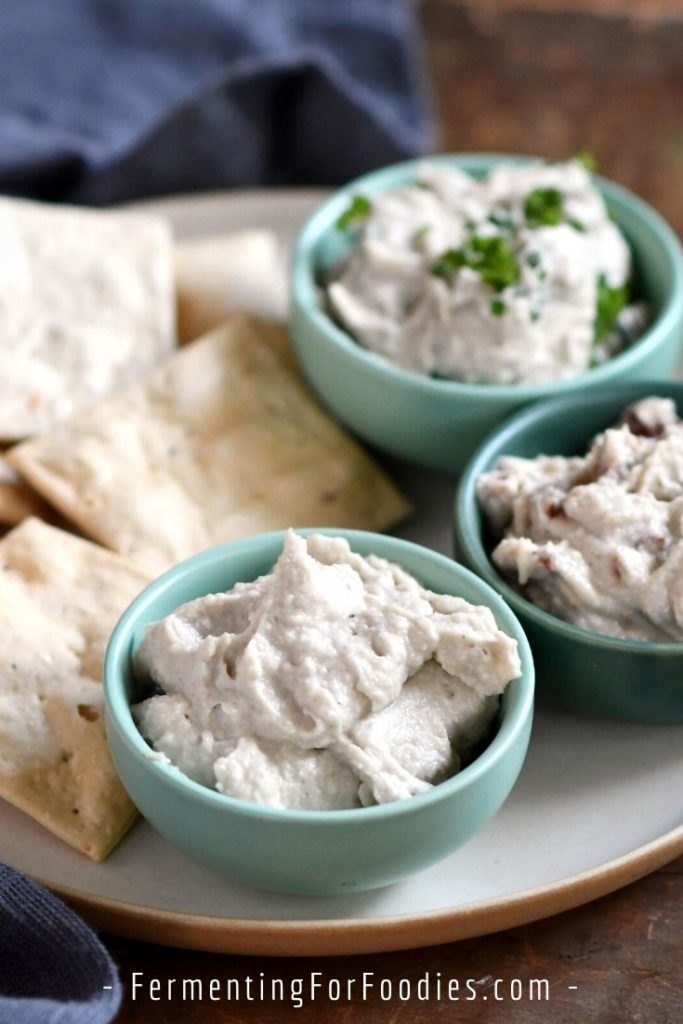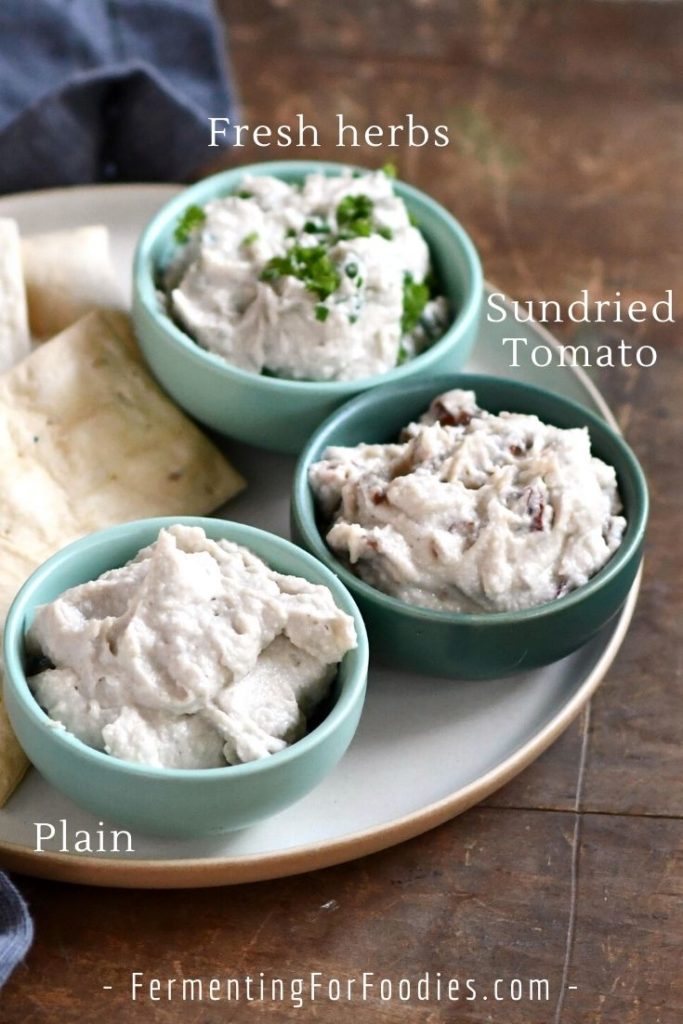This cashew cheese is a miso-fermented cheese-like spread that is perfect for sandwiches, appetizers, and dips. It is vegan, gluten-free, keto, and paleo. Try all 5 flavor options!

Cashews are ideal for dairy-free and cultured snacks. Soaked cashews are naturally creamy and delicious. That’s why my kids love creamy cashew yogurt.
This miso and cashew cheese is a protein-packed, probiotic, and healthy snack. It’s up to you, whether you make it thick, like a cheese spread. Or thin enough to be a dip for vegetables and chips.
5 Flavor Options
The best thing about creamy cashew cheese is that it is perfect for added flavors! The basic recipe results in a spread that is mostly miso-flavored. It’s fine for spreading on sandwiches or serving with crackers.
However, adding some additional flavors turns this everyday dip into something special.
Here are a few of my favorite ways to flavor this spread. Feel free to mix and match. I particularly like the herb and roasted garlic combination.
- Herb: 4 Tbsp finely chopped fresh herbs, salt to taste. I like chives, basil, and parsley.
- Sun-dried Tomato: 1/2 cup finely diced sundried tomatoes.
- Olive: 1 tsp garlic powder, 1/4 cup diced Kalamata olives.
- Roasted Garlic: Roast one head of garlic. Pureed into the cheese, add salt to taste.
- French Onion: This vintage flavor is a real favorite with my kids. Add in 1 package of reduced salt onion soup mix (about 3 Tbsp).
If you’re looking for a sweet cashew dip or spread, try my date-sweetened cashew frosting!

Cashew Cheese
Cashew cheese is a dairy-free cheese spread or dip that can be flavored with garlic, herbs, or sun-dried tomatoes. See the section above for five different ways to flavor this creamy cashew spread.
- Prep Time: 15 minutes
- Total Time: 15 minutes
- Yield: 3 cups 1x
- Category: Side dish
- Method: Fermented
- Cuisine: Healthy
- Diet: Vegan
Ingredients
- 2 cups of raw cashew
- 3 cups of water, to cover (chlorine-free)
- 2 Tbsp miso
- Added flavors (see above)
Instructions
- Cover the cashews in water and soak for 2 to 4 hours.
- Drain the water and blend the cashews into a smooth paste. If you need to add water to help with blending, that’s fine. However, adding extra water will result in a slightly softer cheese spread.
- Blend in the miso and pack the cashew cheese mixture into a glass container. I recommend using a dish that you can use for storage and serving as well. Cap with a tight-fitting lid and place the cashew cheese in a dark location to ferment for 12-48 hours. A kitchen cupboard is perfect.
- After fermenting, mix in any additional flavors that you want to use. You may need to add salt depending on the saltiness of your miso. Store in the refrigerator until you’re ready to serve.
- If you want a cashew dip instead of a spread, add more water until you achieve the desired consistency.
Notes
- The miso needs to be alive to ferment the cashews. Live miso will be in the refrigerated section of your grocery store. You can also find it online
or make it yourself.
- A high-quality blender will make a super smooth cheese.
- I find it’s easiest to store cashew cheese in a glass container as a spreading cheese. However, you can also make cheese logs by rolling the cashew spread into a log-like shape and wrapping it with wax paper or plastic wrap. If you don’t add any additional water during blending, it will hold its shape rather well.
Nutrition
- Serving Size: 1/4 cup
- Calories: 135
- Sugar: 1.3g
- Sodium: 139mg
- Fat: 10.8g
- Saturated Fat: 2.1g
- Carbohydrates: 8g
- Fiber: 0.9g
- Protein: 3.8g
- Cholesterol: 0mg




Hi, during the 12-48 hour countertop fermentation, should the cheese be covered or not? Is this supposed to be anaerobic or no? Thank you!
Either is fine. Miso is mostly anaerobic, so it can be tightly covered. Enjoy!
Hello! I love the blog, and I’ve been making your cashew yoghurt a lot lately – yum! I’m wondering, have you tried this recipe with other nuts? I’m wondering whether walnuts might work… Thanks!
I haven’t tried other nuts, since cashews seem to be the creamiest. I’m currently working on a cookbook, which will include cultured walnuts and cultured sunflower seeds recipes, so I know they will ferment! I think walnuts and pecans would be my second choice for this spread as they are also very creamy when soaked and blended. Let me know how it goes!
hi emillie, do you think it would be ok to experiment with some other starter? I don’t have any miso ready right now…
Yes! I’ve done it with whey… but it wasn’t very good. Maybe try cultured ACV, vegetable brine or unflavored kombucha?
This is such an easy and fun recipe! I was short about 1/2 cup of cashew and so I sub’ed in walnuts. I was worried it would ruin it, but it didn’t. Still tastes great. I used chickpea miso and added chives and herbamare after the fermentation stage. Delicious! Will make again for sure!!!
Sounds delicious!
Hi how long does it last in the fridge?
Hum… I’ve never had it go off, but we typically eat it within 2 weeks. I recommend trying to finish it up within 2 weeks. Enjoy!
Loving this simple recipe, thank you! Does the length of fermentation change the flavour profile? If yes, do you prefer allowing to ferment for the longer option of 48 hours? Thanks!
Hi Emma, The only trick with letting the cashews ferment for too long is that you could end up with mold spores. Usually, this is controlled in miso ferments by the high amount of salt. So while the flavor may continue to develop, it’s probably not worth the risk.
Glad you enjoyed the recipe! Cheers, Emillie
Hi.
Thanks for sharing ur recipe.
How does one know if the miso is alive or dead…poke it and see if it moves? My miso had been in the fridge for quite awhile. Seems too last a long time.
Ha ha 🙂 miso will literally last for YEARS in the fridge. Just make sure it was alive (unpasteurized or raw) to begin with. If you bought it from the refrigerated section of your grocery store, then you’re good. If it was in a sealed bag not in the fridge, then it’s not alive. Cheers!
Good to know. Thanks for the response.
I usually ferment at 35C. On the counter top it may be only 18-20C now over the winter. Is that ok?
This looks really good! I’m new to fermenting, so this may be a dumb question. Could I use pickle brine instead of miso? (Either from a brand like Bubbies or homemade lacto fermented pickles.) Thank you
I’m not sure if Bubbies has a probiotic culture, but fermented pickled juice definitely works! I actually have a dill pickle cashew dip that you may want to try instead. 🙂 https://www.fermentingforfoodies.com/bernies-cashew-dill-pickle-dip-vegan-gf/
That dip looks like what I’m looking for. Thank you so much for your quick reply!